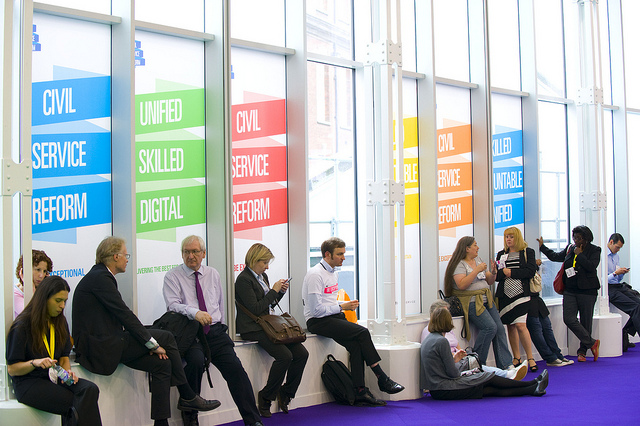Is the UK Civil Service becoming more representative of the population it serves and, if so, why?
The UK Civil Service has long been regarded a bastion of white, middle class men, but there have been efforts to recruit a more diverse workforce in recent years. In this post Rhys Andrews and Rachel Ashworth assess the representativeness of Whitehall staff, in terms of gender, ethnicity and disability. They show that progress has been made in most departments, although there are still questions to be answered about the type of jobs that women, people from ethnic minorities and disabled people tend to hold.

How are women, ethnic minorities and disabled people represented in Whitehall? Credit: Cabinet Office, CC BY-NC 2.0
In recent years policy-makers and politicians have been keen to encourage public organizations to become more diverse, especially within central government. For example, the shadow Cabinet Office Minister Michael Dugher recently stated that a future Labour government would ensure that a greater proportion of Fast Stream civil servants come from black and working class backgrounds. Government has sought to increase the representativeness of the civil service for two main reasons: firstly, so that it is more representative of society and can therefore be viewed as legitimate and, secondly to ensure that policies can generate outcomes that benefit all sections of society.
However, politicians disagree about how a more representative civil service can be achieved. The last Labour government tried to encourage a more diverse workforce through legislative duties, underpinned by a system of recruitment and promotion targets, whereas the current coalition government maintains that progress can still be made in the absence of quotas. In academic terms, whilst the problem of representativeness in public organizations, and especially the civil service, is well-documented, there has been little analysis of the impact of recent reforms. So in a recent paper published in Policy and Politics we asked whether the UK Civil Service was becoming more representative and, if so, which departments have been most successful in this regard. A further question considered whether there are any particular features of those organizations that are associated with greater representativeness.
The Civil Service has a mixed reputation for diversity and equality issues – on the one hand being viewed as a model employer (for example in terms of family-friendly policies) and on the other, still being characterised (and often caricatured) as a white, male-dominated Oxbridge middle class workforce. To address concerns about the representativeness of the civil service, the last Labour government introduced a 10 point plan to improve diversity between 2005 and 2008, followed by an equality and diversity strategy with stringent targets aiming for 39% of senior civil service to be female, 5% from BME backgrounds and 5% with a disability by 2020.
To explore whether the civil service had become more representative during the period of these reforms we analysed levels of female, BME and disabled person’s representation in 21 major Government departments using the civil service statistics for 2007-2009. In our analysis, we found some clear variations in representation between civil service departments. Overall, from 2007-2009 there were increases in female and BME representation in the vast majority of departments (17/21 and 16/21 respectively), along with an increase in the representation of disabled people in over half of departments (14/21). Three departments – Cabinet Office, Ministry of Defence and Department of Health – saw increases in all three types of representation whilst in the Scottish Executive, proportions of disabled and BME staff decreased.
In addition to exploring representation in different departments, we also analysed organizational features which influence levels of representativeness. Our findings suggest that, unsurprisingly, different features impact on the representation of different groups. So, for example, high rates of part-time employment, small workforces, low levels of temporary working and low levels of autonomy (agency status) are connected to higher levels of female representation whilst departmental growth, more autonomy, and low rates of administrative employment were significant in terms of BME representation. Finally, higher rates of administrative employment, small departments and low levels of autonomy (agency status) are associated with disabled people’s employment.
Although our research provides some important insights into the representativeness of the civil service, it leaves us with a series of further questions to consider.
Firstly, it is clear that organizational factors shape representation in different and divergent ways, which implies a need for bespoke initiatives tailored to departmental needs in order to enhance representativeness. This also places a question-mark over the effectiveness of targets and standard equality and diversity policies in the public sector as it seems unlikely that they will deliver improvements across the board.
Secondly, our findings raise a query about the quality and experience of employment in public services for under-represented groups. Is improved representation is a positive development if women and disabled people are concentrated into part-time administrative work? Further, when organizations are more representative, does that make for a more inclusive culture or climate?
Thirdly, our findings raise questions about whether the move to agency status and subsequent devolution of HR policy has been good for equality and diversity. Future studies should examine the ways in which human resource management and equality policies are implemented in practice across the full range of different civil service organizations.
Finally, the data reported in our paper cover the period 2007-2009. A similar analysis conducted in the current period in the absence of targets and characterised by austerity and reductions in employment might well yield some very different results.
—
Read the full article: Andrews, R & Ashworth, R, ‘Determinants of representation: an empirical assessment of the UK civil service’, Policy & Politics, 41 (3), pp.429-448 (free until 3/7/2014)
Note: This post represents the views of the author and does not give the position of Democratic Audit or the LSE. Please read our comments policy before responding.
—
Rhys Andrews is Professor in Public Management at Cardiff Business School. His research interests focus on strategic management, social capital and public service performance. He has published widely in refereed journals including: Human Relations, Journal of Public Administration Research and Theory and Public Administration Review. He is also co-author of Strategic Management and Public Service Performance (Palgrave, 2011) and Public Service Efficiency: Reframing the Debate (Routledge, 2013).
is Professor in Public Management at Cardiff Business School. His research interests focus on strategic management, social capital and public service performance. He has published widely in refereed journals including: Human Relations, Journal of Public Administration Research and Theory and Public Administration Review. He is also co-author of Strategic Management and Public Service Performance (Palgrave, 2011) and Public Service Efficiency: Reframing the Debate (Routledge, 2013).
Rachel Ashworth is Reader in Public Services Management at Cardiff Business School. Her research can be viewed in relation to four key themes: organizational and institutional change in the public sector; scrutiny and accountability in public services, equality and diversity in public services and public service performance. She has published in journals including Journal of Public Administration, Research and Theory, Journal of Management Studies, British Journal of Management, Public Administration, Policy and Politics and Public Management Review. She recently co-edited ‘Theorising Contemporary Public Management Research: International and Comparative Perspectives’, a special issue of the British Journal of Management and also co-edited ‘Public Service Improvement: Theories and Evidence‘ (Oxford University Press, 2010).
is Reader in Public Services Management at Cardiff Business School. Her research can be viewed in relation to four key themes: organizational and institutional change in the public sector; scrutiny and accountability in public services, equality and diversity in public services and public service performance. She has published in journals including Journal of Public Administration, Research and Theory, Journal of Management Studies, British Journal of Management, Public Administration, Policy and Politics and Public Management Review. She recently co-edited ‘Theorising Contemporary Public Management Research: International and Comparative Perspectives’, a special issue of the British Journal of Management and also co-edited ‘Public Service Improvement: Theories and Evidence‘ (Oxford University Press, 2010).





 Democratic Audit's core funding is provided by the Joseph Rowntree Charitable Trust. Additional funding is provided by the London School of Economics.
Democratic Audit's core funding is provided by the Joseph Rowntree Charitable Trust. Additional funding is provided by the London School of Economics.
¿UNA CASTA DIVINA? Is the UK Civil Service becoming more representative of the population it serves and, if so, why? https://t.co/Aq7VC2oMf5
RT @UKCivilService: RT @richard3berry: Is the UK Civil Service becoming more representative of the population it serves and, if so, why? ht…
#HometimeReading Is #OurCivilService becoming more representative of the population it serves? via @democraticaudit https://t.co/E3auwhXev0
Is the Civil Service becoming more representative of UK citizens? asks @democraticaudit, mixed picture https://t.co/QnmDlAaSIf
Interesting blog on whether UK Civil Service is becoming more representative of the population it serves https://t.co/O2mvfQ6VL0
RT @democraticaudit: Is the UK Civil Service becoming more representative of the population it serves & if so, why? https://t.co/SU5aDBJRLz
New on DA today: Is the UK Civil Service becoming more representative of the population it serves and, if so, why? https://t.co/BG4n5cmtvJ
Is the UK Civil Service becoming more representative of the population it serves and, if so, why? https://t.co/GCBo0Yzctu
Is the UK Civil Service becoming more representative of the population it serves and, if so, why? https://t.co/9PYDHtxIrX